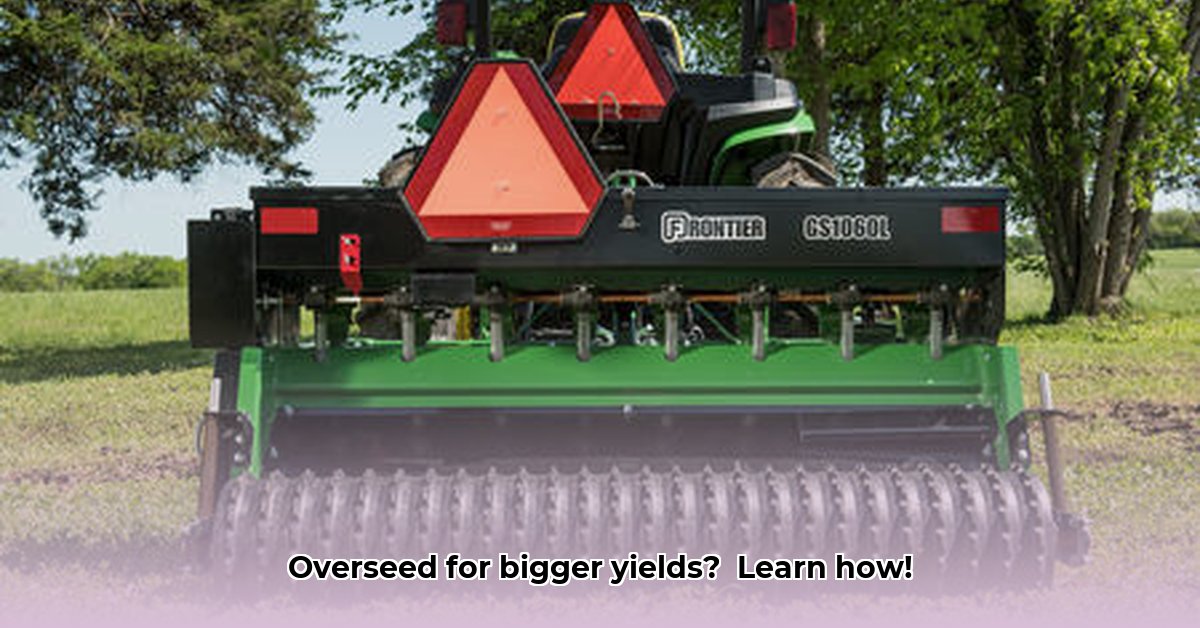
Overseeding, the process of planting new grass seed into existing turf, is crucial for maintaining healthy, productive pastures and lawns. While manual methods are laborious, a tractor overseeder offers unparalleled efficiency and precision. This comprehensive guide will equip you with the knowledge to select, operate, and maintain a tractor overseeder, maximizing your yield and minimizing effort.
Choosing the Right Tractor Overseeder
Selecting the optimal overseeder hinges on understanding your specific needs. Consider these critical factors:
Acreage: Larger fields necessitate wider working widths for faster coverage. A smaller overseeder might suffice for smaller areas, enhancing maneuverability. What size is your acreage?
Terrain: Rocky or uneven terrain demands a robust, durable machine capable of withstanding stress. Conversely, gentle slopes might allow for a lighter, more agile model. What type of terrain are you working with?
Soil Conditions: Compacted soil requires an overseeder designed for optimal seed penetration. No-till operations benefit from models minimizing soil disruption. Are your soil conditions compact or loose?
Budget: Overseeders range in price; balancing features with budget is pivotal. What is your budget for this investment?
Types of Tractor Overseeders
The market offers a variety of overseeders, catering to diverse needs and applications. Common types include:
Broadcast Spreaders: These distribute seeds broadly across the field, suitable for large areas and even seed distribution. However, precision may be slightly lower compared to other methods.
No-Till Overseeders: Designed for minimal soil disturbance, these are ideal for environmentally conscious farming practices. They efficiently plant seeds without significant disruption of the existing soil structure.
Precision Seeders: Offering pinpoint accuracy in seed placement, these models ensure consistent germination and reduce seed wastage. However, they may be slower than broadcast spreaders.
Key Considerations for Overseeder Selection
Before purchasing, carefully evaluate these essential criteria:
Working Width: This determines the area covered per pass. While wider widths accelerate coverage, they might compromise maneuverability in tight spaces.
Seeding Depth Control: Accurate depth control is vital for successful germination. Adjustable settings allow for fine-tuning based on seed type and soil conditions.
Seed Hopper Capacity: A large hopper minimizes refill interruptions, maximizing efficiency. This reduces downtime and improves overall productivity.
Calibration: Precise calibration ensures uniform seed distribution, crucial for even grass growth. Regular calibration checks are essential for maintaining accuracy.
Construction and Durability: Invest in a robust, durable machine capable of withstanding regular use and challenging terrains. High-quality materials contribute to longevity and minimize maintenance.
Overseeding: A Step-by-Step Guide
Follow these steps for optimal overseeding results:
Ground Preparation: Remove debris (rocks, sticks) and consider aerating the existing pasture to improve seed-to-soil contact. This step is particularly crucial for compacted soils.
Calibration: Carefully calibrate the overseeder according to the manufacturer's instructions before beginning. Accurate seed distribution is paramount for uniform growth.
Attachment: Securely attach the overseeder to your tractor, ensuring all safety mechanisms are engaged. Double-check all connections before operation.
Overseeding: Maintain a consistent speed, slightly overlapping passes to avoid gaps. Adjust speed as needed based on terrain and seed type.
Seed-to-Soil Contact: After overseeding, lightly roll the seeded area to improve seed-to-soil contact and encourage germination. This enhances seedling establishment.
Post-Seeding Monitoring: Regularly monitor the pasture's progress, addressing any issues promptly to ensure a successful outcome. Early detection of problems can prevent setbacks.
Pros and Cons of Tractor Overseeding
Weighing the advantages and disadvantages facilitates informed decision-making:
Advantages:
- Significantly increased efficiency compared to manual methods.
- Precise seed placement for optimal germination.
- Even seed distribution leading to uniform growth.
- Reduced labor costs and physical strain.
- Improved pasture health and productivity.
Disadvantages:
- Requires a tractor and operator.
- Higher initial investment cost than manual methods.
- May not be suitable for all terrains.
- Regular maintenance is required.
- Potential learning curve for optimal operation.
Maintenance: Ensuring Longevity
Regular maintenance is crucial for maximizing overseeder lifespan and performance.
- Thoroughly clean the machine after each use.
- Lubricate moving parts according to the manufacturer's recommendations.
- Inspect for wear and tear, addressing any issues promptly.
- Replace worn components as needed.
Key Takeaways:
- Choosing the right tractor overseeder depends heavily on your specific needs and resources.
- Proper calibration and consistent operating techniques are essential for successful overseeding.
- Regular maintenance is crucial for the long-term performance and lifespan of the equipment.
This guide provides a framework for successful tractor overseeding. Remember to always consult your overseeder's manual for specific instructions and safety precautions.